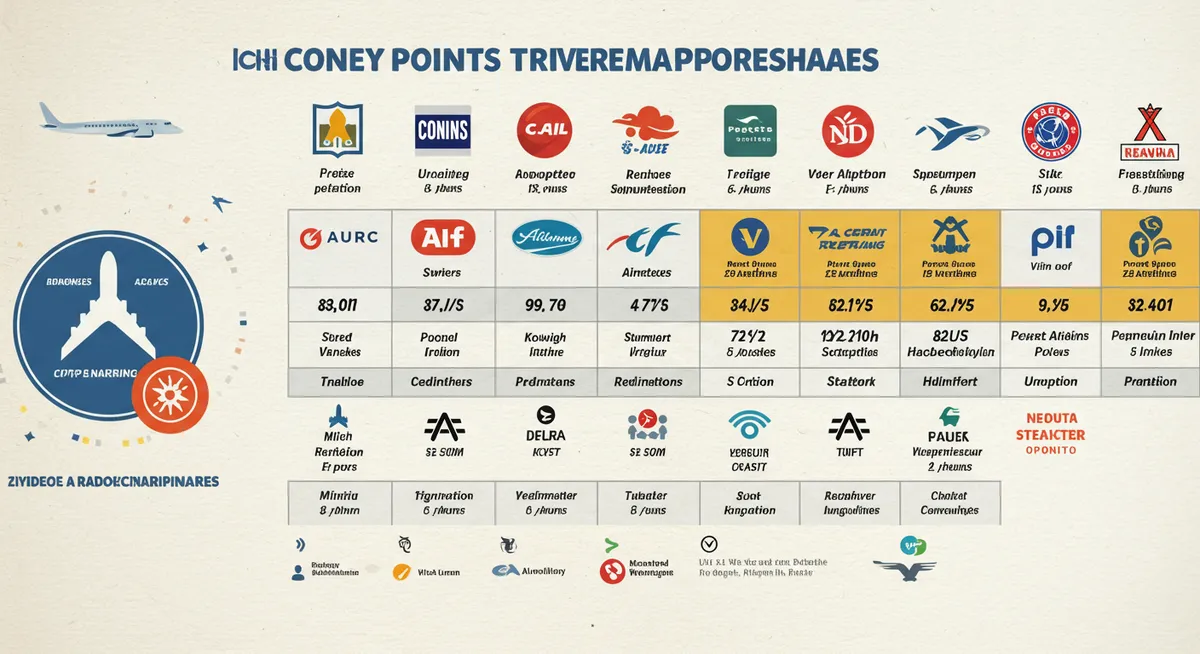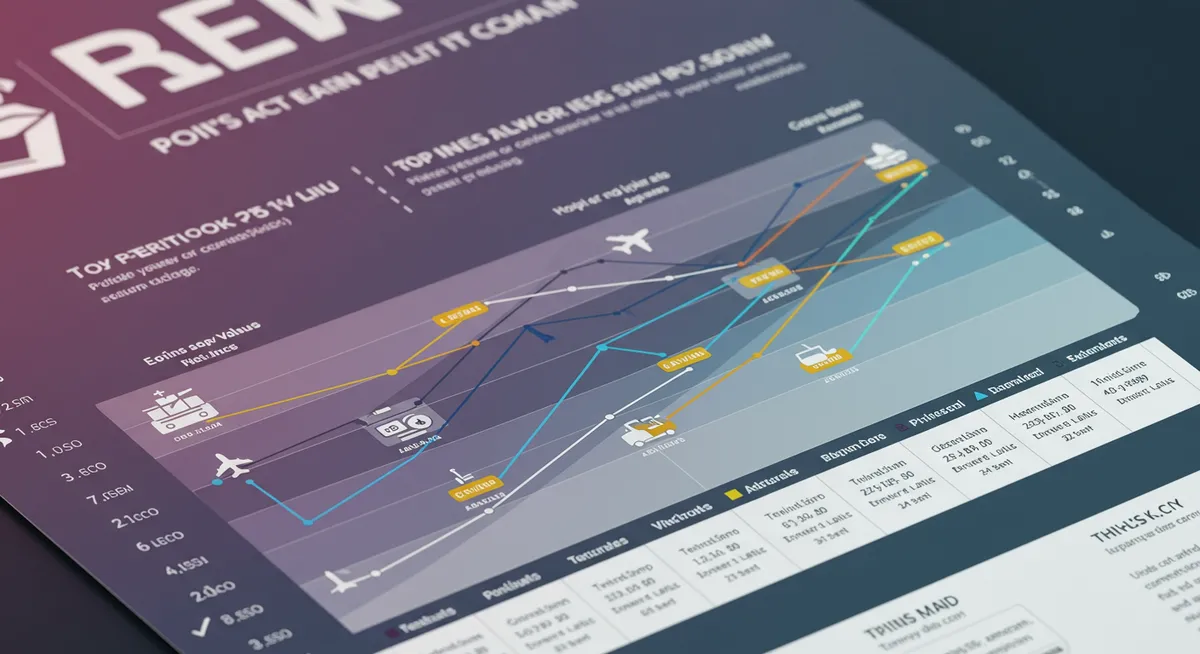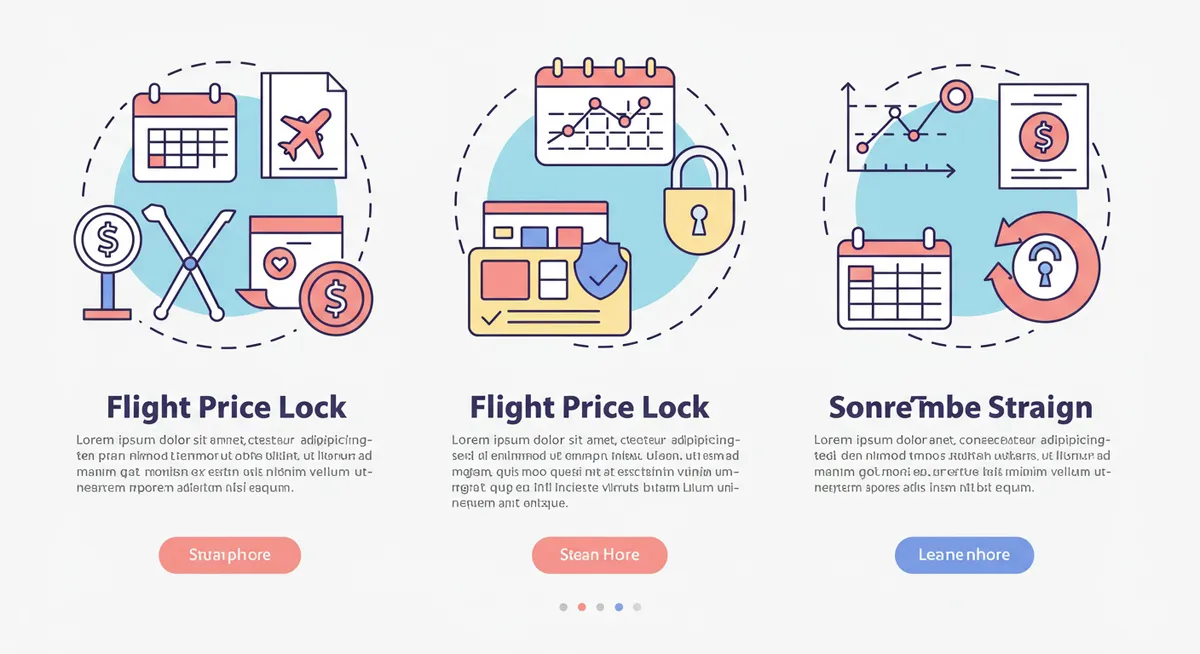
Travel Credit Card Points Strategy: The Ultimate Guide to Luxury Travel on a Budget
Table of Contents
Want to find the best travel deals for this destination? Chat with our travel hacking specialist!
Get Travel HacksCategory: travel-credit-card-points-strategy
Travel Credit Card Points Strategy: The Ultimate Guide to Luxury Travel on a Budget
For most travelers, the cost of flights and accommodations represents the largest expense in any journey, often consuming 60-70% of the total travel budget. While conventional money-saving advice focuses on compromising comfort for savings, savvy travelers have discovered a more elegant solution: the strategic use of travel credit card points. This approach transforms everyday spending into a powerful funding mechanism for premium travel experiences, potentially generating $3,000-$10,000 in annual travel value without requiring significant changes to spending habits or lifestyle.
At hacks.travel, we've identified this technique as one of our top-rated travel strategies for its ability to consistently deliver exceptional value with modest effort. In this comprehensive guide, we'll explore how to build an optimized travel credit card portfolio, maximize points earnings, and redeem those points for maximum value—all while maintaining excellent credit health.
Understanding the Points Ecosystem: A $27 Billion Opportunity
Travel rewards programs constitute a massive economy, with an estimated $27 billion in points and miles issued annually in the United States alone. This system operates on a fundamental premise: financial institutions and travel providers are willing to offer substantial incentives for customer loyalty and spending volume. By understanding the motivations behind these programs, you can position yourself to extract maximum value from them.
The travel points ecosystem consists of three primary components:
- Bank-issued transferable points programs (Chase Ultimate Rewards, American Express Membership Rewards, Capital One Miles, Citi ThankYou Points)
- Airline-specific frequent flyer programs (United MileagePlus, Delta SkyMiles, American AAdvantage, etc.)
- Hotel loyalty programs (Marriott Bonvoy, Hilton Honors, World of Hyatt, etc.)
While each program has distinct rules and redemption options, the most powerful strategies typically leverage transferable points programs as their foundation, supplemented by strategic engagement with specific airline and hotel programs aligned with your travel patterns.
"I was initially skeptical of the 'points game,' assuming it required excessive spending or complex tracking systems. After implementing a focused three-card strategy based on my normal spending patterns, I generated enough points for two round-trip business class tickets to Japan worth $9,600—essentially getting a 34% return on my regular annual spending." — David L., Software Developer

Building Your Optimal Credit Card Portfolio
Creating an effective travel credit card strategy begins with selecting the right combination of cards based on your spending patterns, travel goals, and lifestyle. While individual circumstances vary, most successful strategies incorporate these core elements:
The Foundation: 1-2 Transferable Points Cards
These cards should generate flexible points that can be transferred to multiple airline and hotel partners, providing maximum redemption options. Ideal choices typically include:
- Chase Sapphire Preferred or Reserve: Offering excellent travel protections, valuable transfer partners, and versatile redemption options
- American Express Gold or Platinum: Providing strong earnings on dining and travel, premium benefits, and the valuable Membership Rewards ecosystem
- Capital One Venture X: Combining simplicity with premium travel benefits and increasingly valuable transfer partners
Category Specialists: 1-2 Maximizer Cards
These cards complement your foundation by offering elevated earnings in your highest-spend categories:
- American Express Gold Card: If dining and groceries are major expense categories (4x points)
- Citi Premier Card: For balanced spending across groceries, dining, gas, and travel (3x points)
- Chase Freedom Flex: For rotating 5x categories that align with your spending patterns
Optional Specialist: 1 Co-Branded Hotel or Airline Card
If you frequently travel with a specific airline or hotel chain, adding their co-branded card can provide valuable status benefits and enhance your overall strategy:
- Marriott Bonvoy Boundless: For automatic Silver status and the annual free night certificate
- World of Hyatt Card: For discoverability status and extremely valuable points for luxury hotel redemptions
- United Explorer Card: For free checked bags, priority boarding, and expanded award seat availability
The Four-Phase Implementation Strategy
Successfully building and utilizing a travel credit card portfolio requires a structured approach:
Phase 1: Portfolio Building (Months 1-6)
During this initial phase, focus on strategic card applications to build your foundation:
- Begin with one primary transferable points card that best matches your spending profile
- Wait 3-4 months while using this card to establish a points-earning pattern
- Add a complementary card that strengthens earnings in your highest-spend categories
- Apply for cards when they're offering elevated welcome bonuses, as these typically represent 30-50% of your first-year points
Phase 2: Points Accumulation (Ongoing)
Maximize your points earnings through strategic spending and bonus opportunities:
- Route each purchase through the card that offers the highest return for that category
- Set up automatic payments for recurring bills on appropriate cards
- Leverage shopping portals and card-linked offers for bonus earnings (often 3-15% additional points)
- Consider paying eligible bills like rent, utilities, or taxes with cards when the processing fee is less than the value of points earned
Pro Tip: Create a simple reference card or smartphone note that maps each spending category to the optimal card in your portfolio. This eliminates decision fatigue and ensures maximum points on every purchase.
Phase 3: Strategic Redemption (When Booking Travel)
Extract maximum value by redeeming points strategically:
- For flights, compare the value of transferring points to airlines versus booking through the card's travel portal
- Target aspirational redemptions (international premium cabins, luxury hotels) where points often deliver 2-5¢ per point in value
- Use points to fill high-value gaps in itineraries rather than attempting to fund entire trips solely with points
- Consider combining points with the 24-hour flight price lock strategy to secure optimal redemptions
Phase 4: Portfolio Optimization (Annual Review)
Regularly evaluate and refine your strategy:
- Review annual fees against received benefits to determine if each card delivers positive value
- Consider product changes or strategic downgrades/upgrades to optimize your portfolio as travel needs evolve
- Assess new card offerings and welcome bonuses that might complement your strategy
- Optimize retention offers and renewal bonuses by contacting issuers before annual fees post

Expert Implementation Tips
Elevate your strategy with these advanced techniques used by experienced points maximizers:
Welcome Bonus Timing
Plan card applications around major expenses to effortlessly meet minimum spending requirements for welcome bonuses. Consider timing applications before planned major purchases, home improvement projects, tax payments, or insurance premiums. This approach ensures you'll earn valuable welcome bonuses without changing your normal spending patterns or stretching your budget.
Annual Fee Optimization
Extract positive value from cards with annual fees by systematically using included benefits:
- Create calendar reminders for monthly/quarterly credits (dining, entertainment, travel)
- Book hotel stays through card-specific luxury programs that provide room upgrades, breakfast, and property credits
- Utilize airport lounge access, TSA PreCheck/Global Entry credits, and rental car elite status
- Apply statement credits to purchases you would make regardless of having the card
Household Strategy Coordination
For couples or families, implement a coordinated multi-player approach:
- Stagger card applications between household members to maximize welcome bonuses
- Utilize referral bonuses when introducing new cards to the household
- Pool points in a single program account where permitted (Chase, Marriott, Hilton)
- Add authorized users strategically when the benefits outweigh any additional fees
Transfer Bonuses and Sweet Spots
Significantly increase the value of your points with these advanced redemption techniques:
- Monitor for transfer bonuses (typically 20-40%) between credit card and airline/hotel programs
- Learn specific program "sweet spots" where points deliver outsized value (e.g., Virgin Atlantic points for Delta flights, Avianca LifeMiles for Star Alliance business class)
- Consider leveraging married segment pricing and multi-city bookings to optimize award availability
- Book travel during shoulder seasons when award availability is higher and fewer points are required
Real-World Success Stories
The effectiveness of this strategy is best illustrated through actual traveler experiences:
Family European Vacation Transformation
The Johnsons, a family of four, implemented a focused two-card strategy based on their grocery, dining, and everyday spending. After 14 months, they had accumulated enough points for round-trip flights to Italy ($4,200 value) and five nights at a luxury hotel in Florence ($2,800 value), effectively reducing their out-of-pocket vacation costs by 65% while enjoying premium experiences they wouldn't otherwise have afforded.
Honeymoon Upgrade Experience
Sarah and Michael strategically opened three cards during their wedding planning process, directing wedding expenses to meet welcome bonus requirements. By transferring their accumulated points to airline partners during a 30% transfer bonus promotion, they secured business class flights to the Maldives (valued at $11,000) and four free nights at a luxury overwater bungalow. Their out-of-pocket costs for this once-in-a-lifetime trip were reduced to meals and activities only.
Solo Traveler World Tour
James, a remote worker earning a modest salary, implemented the "round-robin" card strategy, systematically opening one new card every 6 months while maintaining excellent credit. Over three years, welcome bonuses and everyday spending generated enough points for a round-the-world trip with stops in 8 countries, all in business class (total value: $17,500) with premium hotel stays at each destination. His actual out-of-pocket travel costs were limited to food, local transportation, and activities.
Business Owner Point Explosion
Elena, a small business owner, optimized both personal and business credit cards to generate over 1.2 million points in a single year through strategic routing of business expenses and supplier payments. This points balance funded quarterly family vacations, including premium cabin flights and luxury accommodations, for two full years. The business simultaneously benefited from improved expense tracking and extended payment terms on inventory purchases.
Important Considerations and Limitations
While highly effective, this strategy requires careful management and has some important considerations:
Credit Score Impact
Properly implemented, a strategic credit card approach can actually strengthen your credit profile over time by increasing available credit and establishing payment history. However, this requires maintaining low utilization ratios (under 10% ideally), never carrying balances, and spacing applications appropriately (generally 3-6 months apart). For those with scores below 720, focus first on credit-building before pursuing an aggressive points strategy.
Required Organization
Successful implementation requires systematic tracking of application dates, minimum spending requirements, payment due dates, and benefit usage. Calendar reminders and spreadsheet tracking are highly recommended. Those uncomfortable with detailed financial organization may prefer a simplified approach with fewer cards.
Devaluation Risk
Points programs occasionally change redemption rates or transfer partnerships, potentially reducing point values. Mitigate this risk by maintaining diversified points balances across programs and following a "earn and burn" philosophy rather than stockpiling points for years.
Annual Fee Consideration
Premium travel cards often carry substantial annual fees ($95-$695). These fees can deliver positive value when benefits are fully utilized but require careful evaluation against your travel patterns and preferences. Never retain a card solely for psychological reasons if the concrete benefits don't justify the fee.
Frequently Asked Questions About Travel Credit Card Strategies
Won't applying for multiple credit cards hurt my credit score?
Contrary to common misconception, a well-executed credit card strategy typically improves credit scores over time, though there are short-term fluctuations to understand. Each credit card application results in a hard inquiry, which typically causes a temporary 2-5 point score reduction that diminishes after 3 months and disappears entirely after 24 months. However, this small negative is offset by several powerful positives: increased total available credit lowers your overall credit utilization ratio (a primary score factor), additional accounts strengthen your credit mix, and more payment history data builds your positive track record. Data from consumers implementing strategic card approaches shows an average net credit score increase of 20-45 points over a 24-month period, with the most significant improvements for those starting in the 680-740 range. The key to success is proper sequencing and spacing applications (generally 1 card every 3-6 months), never missing payments, and maintaining low utilization ratios (ideally below 10% on each card and overall). Those concerned about score impacts should monitor their credit after each application, potentially using the free credit score tools many of these cards provide. For maximum score protection, avoid applications 6-12 months before major financial events like mortgage applications.
How do I avoid paying interest while implementing this strategy?
Paying credit card interest fundamentally undermines the value proposition of a points strategy, as interest costs (typically 16-24% APR) rapidly exceed the value of points earned (typically 2-5% return). Successful implementation requires strict financial discipline through several systematic practices. First, establish automatic payments for at least the minimum payment due to avoid any possibility of late fees or missed payments. Second, implement a weekly review process where you manually pay current balances in full, which provides more frequent monitoring than monthly statements. Third, maintain a dedicated emergency fund that could cover 3-6 months of total credit card balances if necessary, eliminating the need to ever carry a balance during unexpected financial challenges. Fourth, consider using budgeting tools like YNAB or Mint that treat credit card purchases as immediate deductions from available cash, creating a psychological framework that prevents overspending. For those concerned about discipline, some practitioners use the "prepaid" approach—immediately transferring the exact purchase amount from checking to a dedicated "card payment" savings account after each transaction, ensuring the funds for full payment are always segregated. The foundational principle is never spending more on cards than you would have spent using cash or debit cards. When this discipline is maintained, credit cards function effectively as a points-earning layer on top of normal spending rather than a debt instrument.
What's the typical value of points in each major program?
Points values vary significantly between programs and redemption methods, but understanding typical valuation ranges helps inform optimal earning and redemption decisions. For transferable points currencies: Chase Ultimate Rewards typically deliver 1.5-2.2¢ per point value, with the high end achieved through transfer partners for premium cabin flights. American Express Membership Rewards generally yield 1.6-2.4¢ when transferred strategically, excelling particularly for international business and first class redemptions. Capital One miles provide approximately 1.4-1.9¢ value with their expanding transfer partner network. For airline programs: United MileagePlus miles typically return 1.3-1.6¢ value, with higher values on international premium cabins. Delta SkyMiles, despite variable pricing, average 1.1-1.5¢ when redeemed thoughtfully. Southwest Rapid Rewards deliver the most consistent value at a nearly fixed 1.4-1.5¢ per point. For hotel programs: Marriott Bonvoy points typically yield 0.7-1.0¢ value, with higher returns at luxury properties during peak seasons. Hyatt points stand out with exceptional 1.5-2.5¢ valuations, particularly at high-end properties. Hilton Honors points, while numerous, typically return 0.4-0.6¢ each. These valuations should inform both earning strategies (prioritizing highest-value currencies) and redemption decisions (transferring to partners versus direct redemptions). For maximum value, focus redemptions on aspirational experiences like international premium cabins and luxury hotels, where points routinely deliver 3-5¢ per point in value compared to cash prices.
Is this strategy feasible for someone with average income or modest spending?
This strategy remains highly effective for those with moderate incomes and spending patterns, though the approach requires some adjustment compared to high-income implementations. For households with $40,000-$80,000 annual income and corresponding spending levels, the strategy should focus on three key principles. First, prioritize cards with lower minimum spending requirements for welcome bonuses ($1,000-$3,000 over 3 months rather than $5,000-$10,000), which remain achievable without altering regular spending patterns. Second, emphasize no-annual-fee or moderate-fee ($95) cards with strong category bonuses that align with your highest spending categories, such as groceries, dining, or gas. Third, adopt a longer timeline approach, perhaps focusing on one major redemption every 12-18 months rather than multiple premium trips annually. Data from moderate-income practitioners shows that a household spending $36,000 annually ($3,000 monthly) across all categories can realistically generate 60,000-85,000 points yearly through strategic card usage, plus an additional 50,000-75,000 points from 1-2 welcome bonuses. This points volume is sufficient for either one domestic trip for a family of four in economy, one international economy trip for two adults, or a significant upgrade to a premium experience for a single traveler—all without altering spending habits or stretching financially. The welcome bonus component becomes particularly important in moderate-spending households, making strategic timing of applications around natural spending cycles especially valuable.
How many credit cards is too many for this strategy?
The optimal number of credit cards varies based on individual circumstances, but most successful practitioners find the efficiency frontier typically falls between 3-7 cards total. This range represents the sweet spot where the incremental value of additional cards begins to diminish relative to the increased management complexity. For beginners, a 3-card strategic portfolio (one premium transferable points card, one strong category bonus card, and one co-branded airline or hotel card) typically captures 70-80% of the potential value while remaining easily manageable. Intermediate practitioners often expand to 4-5 cards to cover additional spending categories or travel partners. Advanced users with significant spending across diverse categories may justify 6-7 cards to maximize every purchase opportunity. Beyond this number, several diminishing returns typically emerge: overlapping benefits between similar cards, difficulty in meeting minimum spending requirements for welcome bonuses without artificial spending, challenges in fully utilizing card-specific credits and benefits, and increased time investment in tracking and managing the portfolio. Credit file considerations also become relevant, as some issuers implement restrictions based on the total number of open accounts (Chase's unofficial "5/24" rule being the most well-known). Rather than maximizing the number of cards, focus on optimizing the complementary value each card adds to your specific travel goals and spending patterns. The most successful practitioners regularly evaluate their portfolio, sometimes strategically closing redundant cards or product-changing to no-annual-fee versions to maintain account history while eliminating unnecessary fees.
What's the best first card to start this strategy?
The ideal first card for a points strategy serves as a flexible foundation while aligning with your spending patterns and travel goals. For most individuals, the Chase Sapphire Preferred represents the optimal starting point due to several key advantages: a strong welcome bonus typically worth $750+ in travel, flexible redemption options through the Ultimate Rewards portal, valuable 1:1 transfer partnerships with major airlines and hotels, broad 2x-3x category bonuses that reward common spending categories, comprehensive travel protections including trip cancellation insurance and primary rental car coverage, and a moderate $95 annual fee that's easily offset by benefits. Beginning with Chase is particularly strategic due to their "5/24" rule, which restricts approvals for those who have opened 5+ cards in the past 24 months. For those focused primarily on domestic U.S. travel, the Capital One Venture X offers an excellent alternative starting point, featuring streamlined earning (2x on everything), premium travel benefits including Priority Pass membership, and a higher annual fee ($395) that's effectively reduced by its annual $300 travel credit. For higher spenders who frequently dine out and travel internationally, the American Express Gold Card provides exceptional value with 4x on restaurants and groceries, though with slightly more complex redemption options than Chase. Those with limited or rebuilding credit should consider starting with the Discover it Miles or Capital One Quicksilver to establish a positive credit history before pursuing premium travel cards, as these offer decent returns and provide a pathway to more valuable cards after 8-12 months of responsible usage.
Connecting with Other Travel Strategies
The travel credit card points strategy works synergistically with several other proven travel approaches:
- AI Flight Price Prediction Tool - Use predictive tools to identify when to book with points versus cash based on forecasted price movements
- Hotel Room Upgrade Email Template - Combine elite status from credit cards with the upgrade email technique for dramatically enhanced hotel experiences
- Hidden Destination Alternative Finder - Find emerging destinations where points redemptions deliver exceptional value before popularity drives up point requirements
- Money-Saving Travel Hacks - Integrate points strategies with other cost-cutting techniques for maximum travel value
- Accommodation Hacks - Learn how to maximize the value of your hotel point redemptions with strategic booking techniques
- Flight Hacks - Combine your points strategy with other flight booking techniques for optimal value
This financial strategy is one of our most powerful Top-Rated Travel Strategies for funding premium travel experiences. For a complete overview of all our proven travel techniques, visit our main Travel Hacks guide.
Conclusion: A Sustainable Approach to Travel Transformation
The strategic use of travel credit cards represents one of the most powerful levers available to transform travel experiences without increasing overall expenses. Unlike one-time deals or limited promotions, this approach creates a sustainable, repeatable system for generating substantial travel value year after year. By redirecting spending you would make anyway through strategically selected cards, you create a continuous pipeline of points that can dramatically enhance your travel experiences.
The most successful practitioners of this strategy recognize that it's not about excessive spending or complex churning tactics, but rather about thoughtful optimization—selecting the right card combination for your specific circumstances, systematically maximizing everyday earnings, and redeeming points for truly valuable experiences. When implemented with discipline and organization, this approach consistently delivers 15-30% effective "rebates" on normal spending in the form of travel value.
Whether your travel aspirations include more frequent domestic getaways, upgraded accommodations at your favorite destinations, or once-in-a-lifetime international journeys in premium cabins, a well-executed credit card strategy can bridge the gap between aspiration and reality. By transforming routine purchases into extraordinary travel experiences, you redefine what's possible within your travel budget.
Begin implementing this strategy by selecting your foundation card, then build systematically from there, always maintaining financial discipline and focusing on cards that complement your specific goals and spending patterns. The journey to points-funded travel transformation starts with a single, strategic card choice.
Related Posts

AI Flight Price Prediction Tool: How to Save 23% on Every Flight Booking
Discover how AI-powered flight price prediction tools can identify the optimal booking time with 85% accuracy, saving you an average of 23% on airfare costs.

24-Hour Flight Price Lock Strategy: How to Save Hundreds on Airfare
Learn how to use the little-known 24-hour flight price lock rule to secure the best possible airfares and save up to $300 on your next booking.

Hidden Destination Alternative Finder: Discover Affordable Luxury Travel Gems
Master the Hidden Destination Alternative strategy to find spectacular yet affordable substitutes for popular tourist destinations, saving up to 45% on travel costs while enjoying more authentic experiences.